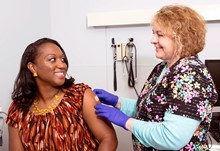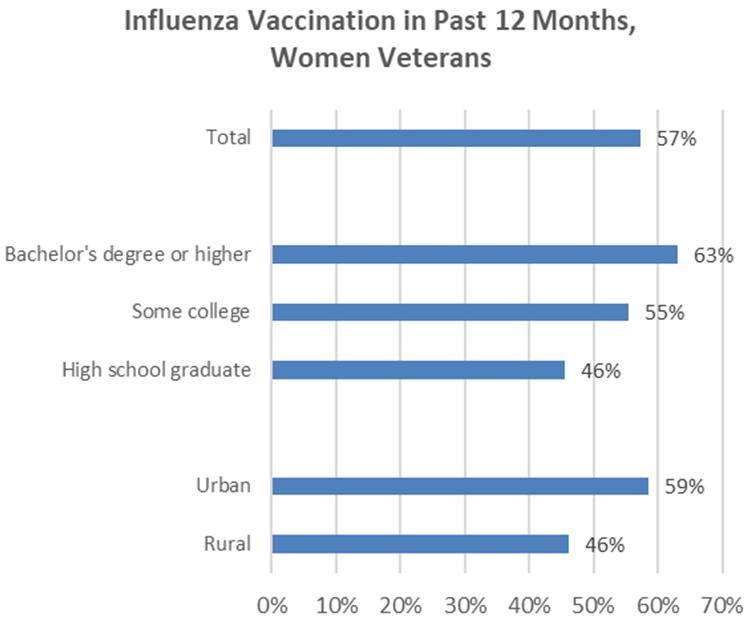Women Veterans and the Flu
|
 |
Download PDF
INTRODUCTION
The Veterans Health Administration (VHA) serves a Veteran population that is increasingly diverse. Equitable access to high-quality care for all Veterans is a major tenet of the VA healthcare mission. The Office of Health Equity (OHE) champions the elimination of health disparities and achieving health equity for all Veterans.
There are 1.9 million women Veterans, 9.4% of the Veteran population. Influenza vaccine uptake among females has decreased from about 73% to 64%. During the 2009 H1N1 pandemic in the United States, females were more likely to develop severe disease than males and accounted for 53.2% of hospitalizations.

PREGNANCY AND FLU VACCINATION DISPARITIES
Pregnant women are 5 times more likely than non-pregnant women to experience severe illness with influenza infection. For pregnant women, getting a flu shot is the first and most important step in protecting against flu. The flu shot given during pregnancy has been shown to protect both the mother and her baby (up to 6 months old) from flu.
Millions of pregnant women have received influenza vaccines over the past decade. Influenza vaccines causes no harm to pregnant women or their infants and there is no increased chance of developing autism in the babies of women who receive the flu vaccine. In fact, vaccination during pregnancy protects the mother and her infant (up to 6 months of age) from illness, hospitalization, preterm birth, and flu-related pneumonia and death.
Maternal vaccination rates remain poor in the US, despite the recommendation to vaccinate pregnant women, the known risk of influenza to pregnant women and their infants, and the demonstrated safety of the vaccine. In a Centers for Disease Control and Prevention (CDC) survey of women who were pregnant during the 2017-2018 influenza season, only 49 percent of respondents reported receiving the influenza vaccination before or during pregnancy
REDUCING DISPARITIES AND IMPROVING ACCESS TO CARE
The Office of Health Equity supports national and local efforts by VA to reduce health disparities and increase access to services among Women Veterans. Pregnant Veterans may get the influenza vaccine at VA facilities. Pregnant Veterans using the VA maternity benefit may also get the influenza vaccine from their maternity care provider; immunizations are covered under the maternity benefit authorization.
FLU SHOTS THROUGH VA'S COMMUNITY CARE NETWORK (CNN)
Beginning September 1, 2020, in addition to availability at VA medical facilities, eligible Veterans can receive the seasonal flu vaccination through Community Care Network (CCN) via in-network retail pharmacy and urgent care locations. To be eligible, Veterans MUST be enrolled in the VA health care system AND have received care through VA from either a VA or community provider within the past 24 months. To check eligibility, Veterans can contact their local VA medical facility OR call 844-MyVA311 (844-698-2311), select option 1, and then select option 1 again.
Veterans can find an in-network pharmacy or urgent care location providing flu shots at https://www.va.gov/find-locations. Eligible Veterans whose visit to an in-network retail pharmacy or urgent location that consists of only a flu shot will not incur a copayment.
It is important that Veterans call ahead and make sure that the clinic is open and able to provide flu shots before going to the pharmacy in the community. Upon arriving, Veterans must present a government-issued identification card like their Veterans Health Identification Card or a Driver’s License to receive a flu shot at no-cost.
For full information about where to obtain a flu shot at in-network community locations, visit https://www.va.gov/communitycare/flushot.asp.
For more information about the Office of Health Equity visit: https://www.va.gov/healthequity/
For additional OHE fact sheets and information briefs visit: https://www.va.gov/HEALTHEQUITY/Publications_and_Research.asp
REFERENCES
Kahn KE, et al., Influenza and Tdap Vaccination Coverage Among Pregnant Women - United States, April 2018. MMWR Morbidity and Mortality Weekly Report. 2018;67(38):1055.



















